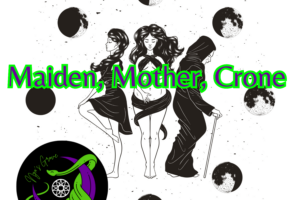What is St. Patrick’s Day?
Originating in the 9th or 10th century, St. Patrick’s Day, or the Feast of Saint Patrick and has been around for over 1,000 years. It is a celebration of Ireland’s Patron Saint, Saint Patrick on the day of his death, March 17th. The feast typically falls during the Christian season of Lent, which is a period where there is a prohibition of eating meat. This prohibition is typically waived on this day so the people can celebrate by dancing, drinking, and feasting on the traditional Irish bacon and cabbage. More recently, we link St. Patrick’s Day with the color green, leprechauns, getting drunk, and eating corned beef, potatoes, and cabbage. Which, if I’m being honest, is probably close to what it was in the past as well.
But we aren’t here to talk about the day itself, I want to go into who Saint Patrick was and why we are celebrating him in the first place, because his history in Ireland had big implications for the Pagan community.
Who is Saint Patrick?
Most of the information we have on Saint Patrick’s youth is from his own autobiography The Confessio, which means, there could be some personal embellishments in the tale, so just remember to take everything with a grain of salt. If you are interested in reading St. Patrick’s confessions, it can be read here. If you don’t want to read it, I will be roughly going over what he wrote, as well as other reports of his life.
St. Patrick, reportedly named Maewyn Succat, was born around 386AD to a well-off family that lived on the western coast of Great Britian, the area is most likely Wales, which was a part of the Roman Empire at the time. His father was a Christian Deacon and a minor Roman Official, his grandfather was a priest. In his confession, he admits that as a young boy, Patrick did not agree with his family’s faith. He believes that that is the reason for everything that happened to him.
Early in the 5th century, when Maewyn was roughly 16 years old, a band of Irish marauders, or pirates, raided the small village of Banavem Taburniae. While they were raiding the village, they captured 9 people for the Niall, Ireland’s King. Maewyn was one of the people that the pirates captured. He claims that they brought him back to Ireland and sold him in the slave trade to herd sheep for a local chieftain. While in slavery, he was deprived of clothing and food. He attributes his time in captivity to the bloom of his faith. He wrote that he prayed daily and that is what helped him survive the 6 years he was confined in Ireland. He claims that while he was in captivity, an angel came to him while he was sleeping one night and told him that he would return to him homeland once again. That the angel told him of a ship that was leaving Ireland and that God would be with him on the journey home.
This is what prompted Maewyn to escape his captivity and walk an estimated 200 miles across peat moss and forests to the port where the ship was going to be. When he got to the port, the captain of the ship originally turned him away. He said that he left the port and went to pray and while he was praying, he heard one of the men call him and tell him to hurry up and get on the ship. Once on the ship, of primarily Pagan crewmates, he soke to them about his beliefs in attempts to convert them to Christianity.
When the ship finally arrived on land, Maewyn and the crew were stranded walking through the wilderness for a few weeks stranded without knowing where to go or how to get food. It was during this time, that the crew started to criticize him for his faith, claiming that if his god was so powerful and helpful, why can’t he pray to his god to help them while they are lost without food. This prompted Maewyn to pray with the Pagan crew for guidance and food. He claimed that after they prayed, a stampede of pigs crossed their path giving them the food they needed to survive. The crew of the ship would be the first group of people that were converted to Christianity by Saint Patrick.
Eventually, Maewyn made it back to Great Britian and his family. Who after hearing his retelling of the events, begged him not to leave them again. He reports his religious visions returned shortly after coming home. He claims that in the visions he saw a man carrying letters and, in the letters, he could see and hear the voices of the Irish people begging for him to return to Ireland and lead them to God. This started his religious training. He was ordained as a Deacon in roughly 418AD. He was then consecrated as a Bishop around 432AD. This was when he was given the name Saint Patricius, or Patrick.
The newly made Bishop then requested to be assigned to the missionary in Ireland, where he spent the rest of his life using his knowledge of the culture and language from when he was captive there to his benefit. Saint Patrick worked at converting as many people as he could while he was in Ireland. Claiming to have converted them by the thousands. He claims to have baptized all the Druid priests, Chieftains, and Aristocrats in Ireland. He used common imagery to trick people into thinking that the Christian God was all around them, He would use the shamrock, or three-leaf clover as an example of the Holy Trinity. He continued to do this and act and Ireland’s Patron Saint until his death in 461AD. It is rumored that he died on the equivalent of March 17th, which is why the feast of St. Patrick is celebrated on March 17th every year.
Disbelief of Patrick’s Story
There are some people that believe the retelling of Saint Patrick’s early life is nothing more than a story that he wanted to enhance about himself. The working theory is that young Maewyn was not captured by the Irish marauders, but instead, ran to Ireland to avoid being forced to inherit his father’s job of being a tax collector. At the time, the Roman empire was starting to fall, which made being a tax collector an increasingly dangerous and financially risky job because the collectors at the time were responsible for personally covering any shortfalls they came across. It is claimed that instead of entering Ireland as a slave, he introduced himself as a wealthy slave trader.
These theories are backed up by the fact that the transportation of goods at the time did not run smoothly, so the chances that a roughly 22-year-old food and clothing deprived man made it through the transport system from Ireland to Britain was slim, let alone the supposed 200-mile trek to get from where he escaped to the port.
Because there really isn’t a well-documented telling of his life from an outside perspective, it is highly likely that he did exaggerate his life story to make it sound better for his cause of converting people to his faith. That being said, we don’t really have any proof that what he claims didn’t happen either. I will say, there is documentation that he was not truthful about some of his other legends, which we are about to go into now.
St. Patrick and the Snakes
One of the main tales of Saint Patrick is that he “rid Ireland of the snakes”. It is a good contributing factor of the celebration of the Feast of St. Patrick. The legend states that the Patron Saint of Ireland was fasting for 40 days on top of a hill when snakes started to attack him. He claims that he chased them down the hill and into the ocean, effectively ridding Ireland of the snakes.
Science aside, yes, it is possible he could have run snakes down the side of the hill and out into the ocean, it is a longshot to claim that he rid Ireland of snakes in with one hill. What’s even better, is science exists and researchers have been able to survey the land in Ireland and determine that because of the temperature and earlier ice ages, Ireland is not habitable, nor has it ever been habitable to most reptiles. So, the tail of him physically ridding the county of snakes is essentially impossible.
The story of Saint Patrick and the snakes most likely is a metaphor for his Christianization of Ireland. The snakes being the Pagan that lived there at the time, and the Christianization being the eradication of them. At the time, snakes were heavily considered to be evil and synonymous for the devil because of their portrayal in Adam and Eve’s fall in the bible. It was also wildly thought throughout the Christian belief (still is) that if you are following any other path then Christianity, you were following the Devil.
My thoughts
So, I did not expect to be as interested in this topic as much as I am. As much as I HATED researching and writing things in school, I am finding it very enjoyable now. Also, full disclosure, I went into this expecting to essentially shit on St. Patrick for what he did. Somewhere along the line of research I started to realize that he was just following his faith, which I can’t necessarily fault… I still find the idea of trying to Christianize anything is deplorable. It’s no one’s place to tell anyone what their faith should be, but after reading his dying confession, the empath in me couldn’t help but connect with the fear that he was writing. He seemed to spend his entire life thinking that his god was going to turn his back on him. Don’t get me wrong, it doesn’t make me like him, especially because I do think part of what he wrote is a parodied version of the truth, but it does make me pity him and what he potentially went through.
Discover more from Nyx's Grove
Subscribe to get the latest posts sent to your email.




Leave a Reply